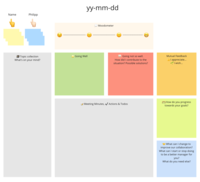
One-on-Ones are one of the most important and powerful tools for leaders. If done well, they can help you to spot issues before they escalate, unblock, establish trust, foster a culture of mutual feedback, and ensure the growth of all participants. This post provides a template incorporating the principles for great one-on-ones to achieve this more easily.

Good performance reviews should be as fair and objective as possible, communicate expectations clearly, and point out concrete areas of improvement. For this, we use a skill matrix as a systematic assessment tool containing skills tailored to the role of a software developer. This post is a hands-on guide to applying a skill matrix in practice.

Management is not something you “just do intuitively” and it will work out by itself. Instead, management is a craft that you can - and should - learn. It’s about knowing the right tools and approaches and learning skills that help you to lead a productive, happy and motivated team. In this post, we visualize these skills as a “Skill Tree” like in a video game. Have a look. It will be fun and insightful!

1-1s are the most important tool for every team manager. If done right, 1-1s can support the report to grow, to become and stay happy, motivated, and productive. However, you need a certain toolkit for 1-1s. This toolkit contains different 1-1 types, records, questions, personal notes, journey maps, and software that can be applied in practice.

Traditional hierarchy-based feedback flows are limited as they don’t consider the useful feedback of peers. To improve this, I suggest a “Complete Peer Feedback” session: All team members come together and share their appreciation and growth potential for their peers. In this post, I present our experiences with this approach, why we are enthusiastic about it and how you can adopt it.

Employee journey maps are a tool for preparing and structuring staff appraisals. They trigger reflection processes and reveal the employee’s motivation. Moreover, they can lead to interesting insights as they compare the different perceptions of the participants. And the best is: You only need two sheets of paper and a pencil.

Code reviews are powerful means to improve the code quality, establish best practices and to spread knowledge. However, code reviews can come to nothing or harm interpersonal relations when they are done wrong. Hence, it’s important to pay attention to the human aspects of code reviews. Code reviews require a certain mindset and phrasing techniques to be successful. This post provides both the author and the reviewer with a compass for navigating through a constructive, effective and respectful code review.






